2019 Hyundai Santa Fe battery
[x] Cancel search: batteryPage 568 of 682

6-30
What to do in an emergency
5. Insert the sealant bottle into the
housing of the compressor (4) so
that the bottle is upright.
6. Ensure that the compressor is
switched off, position 0.7. Connect TMK cables to the bat-
tery in numerical order.
➀RED cable : (+) battery terminal
➁BLACK cable : (-) battery termi-
nal8. With the engine start/stop button
position on or ignition switch posi-
tion on, switch on the compressor
and let it run for approximately
5~7 minutes to fill the sealant up
to proper pressure. (refer to the
Tyre and Wheels, section 8). The
inflation pressure of the tyre after
filling is unimportant and will be
checked/ corrected later.
Be careful not to overinflate the
tyre and stay away from the tyre
when filling it.
OTM068008
Securely install the sealant fill-
ing hose to the valve. If not,
sealant may flow backward,
possibly clogging the filling
hose.
CAUTION
•TMK cable connection can be
dangerous if done incorrectly.
Therefore, to avoid harm to
yourself or damage to TMK or
battery, follow the TMK cable
connection procedures.
•When disconnecting TMK
cables, disconnect BLACK (-)
cable first from the battery
and then disconnect RED (+)
cable.
•Be careful the spark from the
battery when connect or dis-
connect the battery cables.
CAUTION
ODM063019
Page 576 of 682
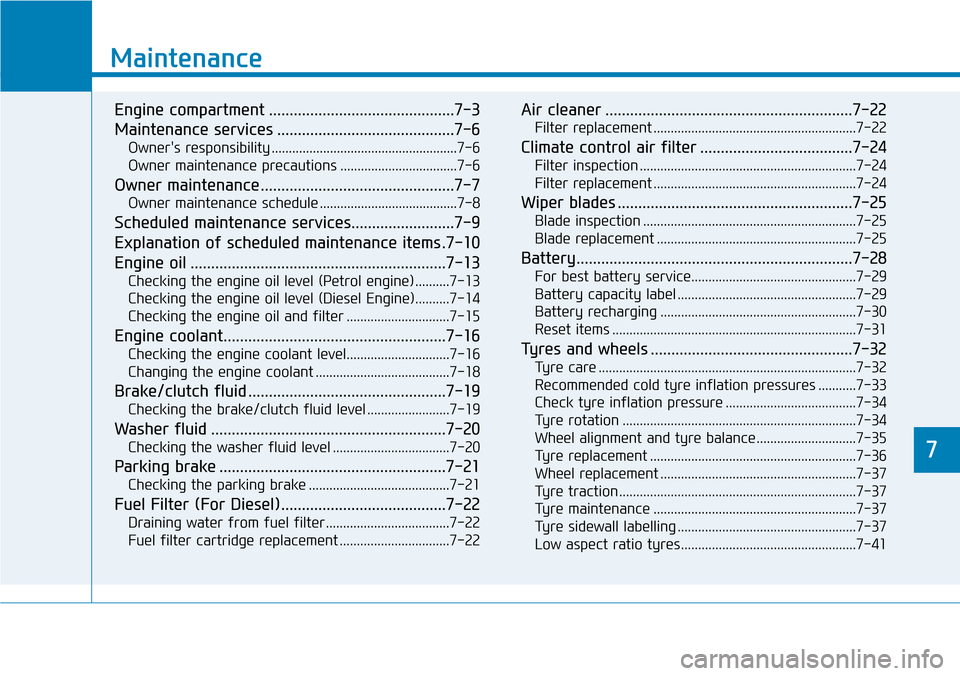
7
Maintenance
7
Maintenance
Engine compartment .............................................7-3
Maintenance services ...........................................7-6
Owner's responsibility ......................................................7-6
Owner maintenance precautions ..................................7-6
Owner maintenance ...............................................7-7
Owner maintenance schedule ........................................7-8
Scheduled maintenance services.........................7-9
Explanation of scheduled maintenance items .7-10
Engine oil ..............................................................7-13
Checking the engine oil level (Petrol engine) ..........7-13
Checking the engine oil level (Diesel Engine)..........7-14
Checking the engine oil and filter ..............................7-15
Engine coolant......................................................7-16
Checking the engine coolant level..............................7-16
Changing the engine coolant .......................................7-18
Brake/clutch fluid ................................................7-19
Checking the brake/clutch fluid level ........................7-19
Washer fluid .........................................................7-20
Checking the washer fluid level ..................................7-20
Parking brake .......................................................7-21
Checking the parking brake .........................................7-21
Fuel Filter (For Diesel)........................................7-22
Draining water from fuel filter ....................................7-22
Fuel filter cartridge replacement ................................7-22
Air cleaner ............................................................7-22
Filter replacement ...........................................................7-22
Climate control air filter .....................................7-24
Filter inspection ...............................................................7-24
Filter replacement ...........................................................7-24
Wiper blades .........................................................7-25
Blade inspection ..............................................................7-25
Blade replacement ..........................................................7-25
Battery...................................................................7-28
For best battery service................................................7-29
Battery capacity label ....................................................7-29
Battery recharging .........................................................7-30
Reset items .......................................................................7-31
Tyres and wheels .................................................7-32
Tyre care ...........................................................................7-32
Recommended cold tyre inflation pressures ...........7-33
Check tyre inflation pressure ......................................7-34
Tyre rotation ....................................................................7-34
Wheel alignment and tyre balance.............................7-35
Tyre replacement ............................................................7-36
Wheel replacement .........................................................7-37
Tyre traction .....................................................................7-37
Tyre maintenance ...........................................................7-37
Tyre sidewall labelling ....................................................7-37
Low aspect ratio tyres...................................................7-41
7
Page 578 of 682
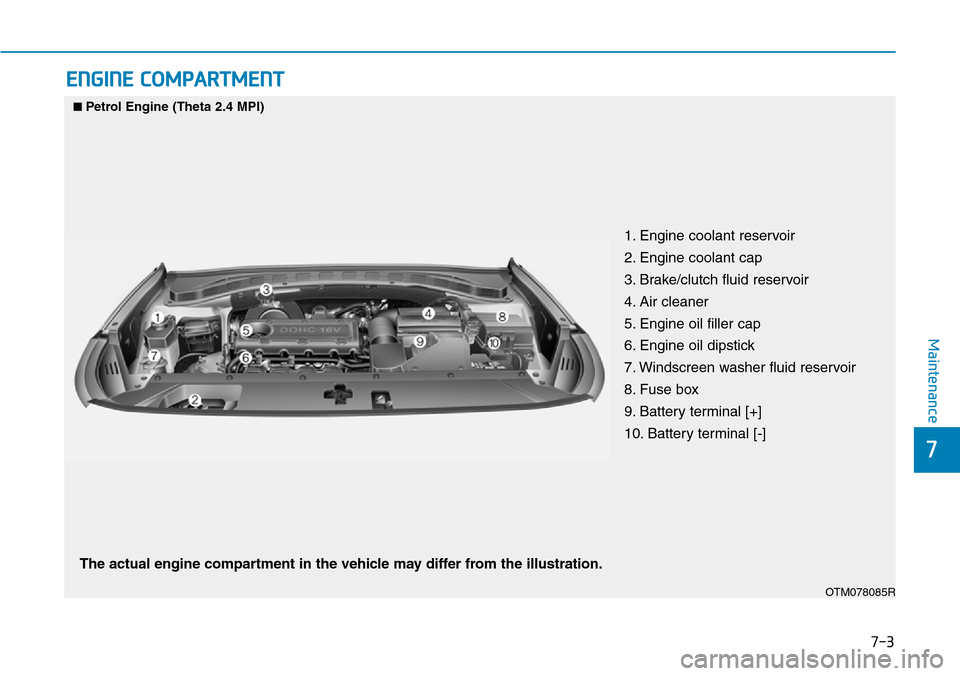
7-3
7
Maintenance
ENGINE COMPARTMENT
1. Engine coolant reservoir
2. Engine coolant cap
3. Brake/clutch fluid reservoir
4. Air cleaner
5. Engine oil filler cap
6. Engine oil dipstick
7. Windscreen washer fluid reservoir
8. Fuse box
9. Battery terminal [+]
10. Battery terminal [-]
OTM078085R
■Petrol Engine (Theta 2.4 MPI)
The actual engine compartment in the vehicle may differ from the illustration.
Page 579 of 682
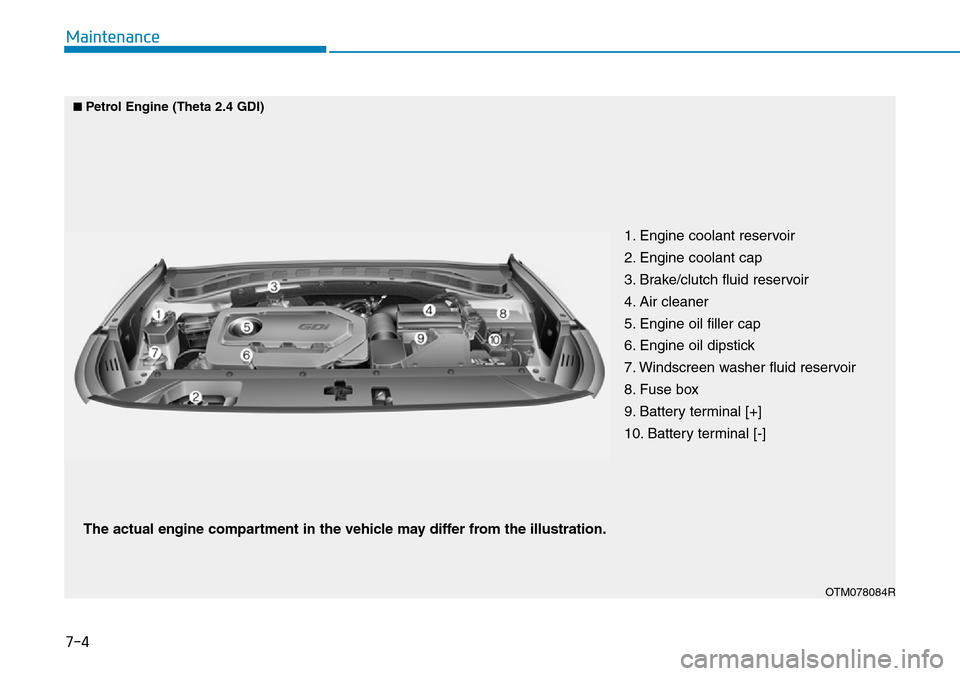
7-4
Maintenance
1. Engine coolant reservoir
2. Engine coolant cap
3. Brake/clutch fluid reservoir
4. Air cleaner
5. Engine oil filler cap
6. Engine oil dipstick
7. Windscreen washer fluid reservoir
8. Fuse box
9. Battery terminal [+]
10. Battery terminal [-]
OTM078084R
■Petrol Engine (Theta 2.4 GDI)
The actual engine compartment in the vehicle may differ from the illustration.
Page 580 of 682
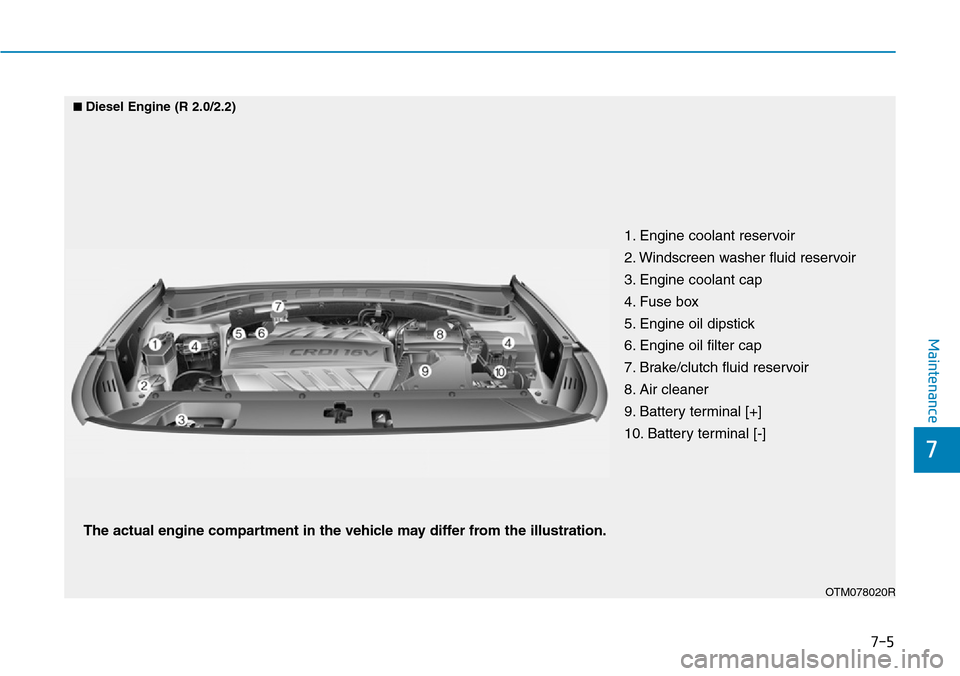
7-5
7
Maintenance
1. Engine coolant reservoir
2. Windscreen washer fluid reservoir
3. Engine coolant cap
4. Fuse box
5. Engine oil dipstick
6. Engine oil filter cap
7. Brake/clutch fluid reservoir
8. Air cleaner
9. Battery terminal [+]
10. Battery terminal [-]
OTM078020R
■Diesel Engine (R 2.0/2.2)
The actual engine compartment in the vehicle may differ from the illustration.
Page 582 of 682

7-7
7
Maintenance
OWNER MAINTENANCE
The following lists are vehicle checks
and inspections that should be per-
formed by the owner or a HYUNDAI
authorised repairer at the frequencies
indicated to help ensure safe, depend-
able operation of your vehicle.
Any adverse conditions should be
brought to the attention of your dealer
as soon as possible.
These Owner Maintenance vehicle
checks are generally not covered by
warranties and you may be charged
for labour, parts and lubricants used. Performing maintenance work
on a vehicle can be dangerous.
If you lack sufficient knowledge
and experience or the proper
tools and equipment to do the
work, we recommend that the
system be serviced by a
HYUNDAI authorised repairer.
ALWAYS follow these precau-
tions for performing mainte-
nance work:
•Park your vehicle on level
ground, move the shift lever
into the P (Park, for automatic
transmission vehicle) position
or neutral (for manual trans-
mission vehicle) position,
apply the parking brake, and
place the ignition switch in
the LOCK/ OFF position.
•Block the tyres (front and
back) to prevent the vehicle
from moving.
Remove loose clothing or jew-
ellery that can become entan-
gled in moving parts.
WARNING •If you must run the engine
during maintenance, do so
out doors or in an area with
plenty of ventilation.
•Keep flames, sparks, or smok-
ing materials away from the
battery and fuel-related parts.
Diesel Engine
Never manipulate or modify the
injection system whilst running
the diesel engine or within 30
seconds after turning OFF the
diesel engine. The high-pressure
pump, high-pressure pipes, rail,
and injectors are still subject to
high pressure immediately after
stopping the diesel engine.
When the fuel leakage vents out,
it may cause serious body injury.
Any people, who are implanted
with the artificial cardiac pace-
maker, should remain away from
the ECU or the wiring harness by
at least 30 cm, whilst running the
diesel engine. The high currents
of the electronic engine control
system produce a considerable
amount of magnetic fields.
WARNING
Page 584 of 682
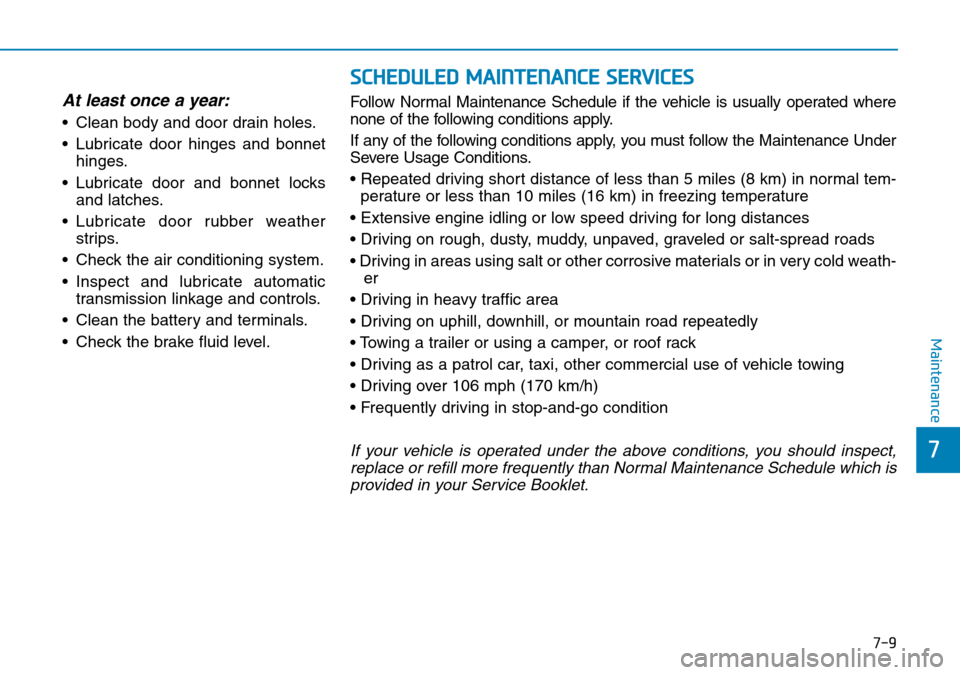
7-9
7
Maintenance
SCHEDULED MAINTENANCE SERVICES
At least once a year:
• Clean body and door drain holes.
• Lubricate door hinges and bonnet
hinges.
• Lubricate door and bonnet locks
and latches.
• Lubricate door rubber weather
strips.
• Check the air conditioning system.
• Inspect and lubricate automatic
transmission linkage and controls.
• Clean the battery and terminals.
• Check the brake fluid level.Follow Normal Maintenance Schedule if the vehicle is usually operated where
none of the following conditions apply.
If any of the following conditions apply, you must follow the Maintenance Under
Severe Usage Conditions.
• Repeated driving short distance of less than 5 miles (8 km) in normal tem-
perature or less than 10 miles (16 km) in freezing temperature
• Extensive engine idling or low speed driving for long distances
• Driving on rough, dusty, muddy, unpaved, graveled or salt-spread roads
• Driving in areas using salt or other corrosive materials or in very cold weath-
er
• Driving in heavy traffic area
• Driving on uphill, downhill, or mountain road repeatedly
• Towing a trailer or using a camper, or roof rack
• Driving as a patrol car, taxi, other commercial use of vehicle towing
• Driving over 106 mph (170 km/h)
• Frequently driving in stop-and-go condition
If your vehicle is operated under the above conditions, you should inspect,
replace or refill more frequently than Normal Maintenance Schedule which is
provided in your Service Booklet.
Page 592 of 682

7-17
7
MaintenanceThe electric motor for the cooling fan
is controlled by engine coolant tem-
perature, refrigerant pressure and
vehicle speed. As the engine coolant
temperature decreases, the electric
motor will automatically shut off. This
is a normal condition. If your vehicle
is equipped with GDI, the electric
motor for the cooling fan may begin
to operate at any time and continue
to operate until you disconnect the
negative battery cable.
Recommended engine coolant
• When adding coolant, use only dis-
tilled (deionised) water for your
vehicle and never mix hard water in
the coolant filled at the factory. An
incorrect coolant mixture can result
in serious malfunction or engine
damage.
• The engine in your vehicle has alu-
minium engine parts and must be
protected by an ethylene-glycol
with phosphate based coolant to
prevent corrosion and freezing.
• DO NOT USE alcohol or methanol
coolant or mix them with the spec-
ified coolant.
• Do not use a solution that contains
more than 60% antifreeze or less
than 35% antifreeze, which would
reduce the effectiveness of the solu-
tion. The electric motor for
the cooling fan may
continue to operate
or start up when the
engine is not running
and can cause serious injury.
Keep hands, clothing and tools
away from the rotating fan blades
of the cooling fan.WARNING
Never remove the
coolant cap/radiator
cap or the drain plug
whilst the engine and
radiator are hot. Hot
coolant and steam may blow out
under pressure, causing serious
injury.
Turn the engine off and wait until
the engine cools down. Use
extreme care when removing the
coolant cap/radiator cap. Wrap a
thick towel around it, and turn it
counterclockwise slowly to the
first stop. Step back whilst the
pressure is released from the
cooling system. When you are
sure all the pressure has been
released, press down on the cap,
using a thick towel, and continue
turning counterclockwise to
remove it.
WARNING